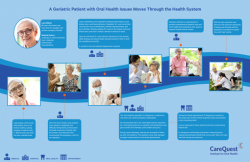This is part of a series of case studies that depict various types of oral health care coordination. The series is designed to illustrate how individuals may interact with the health care system, demonstrate communication between providers, and highlight the importance of oral health information exchange.
Ms. Lena Walton is an 86-year-old woman with moderate to severe dementia, type 2 diabetes, hypertension, and hyperlipidemia. She lives with her daughter, Pamela, who serves as her primary caregiver along with her two sisters who take turns staying with Lena during the day. As her dementia has progressed, she requires increasing assistance to perform activities of daily living (ADLs) such as dressing, toileting, and bathing, but she enjoys reminiscing about the past, eating favorite foods including biscuits and roast chicken, and listening to music with her family.
One morning, one of Lena’s front teeth breaks while she is eating breakfast. Because her mobility is limited, making outpatient medical visits is very difficult for Lena and Pamela, and Lena does not have a dental home. Lena does not seem to be upset by her broken tooth and so Pamela does not seek further care. Over two weeks, Pamela notices that Lena has less interest in her meals and is eating less. She tries to serve her softer foods like mashed potatoes, but Lena is less interested in these than her preferred foods. Over the next two weeks, Lena requires even more support to ambulate and transfer from a chair and becomes less talkative. Pamela and her sisters also notice that Lena it is very difficult to get Lena to take in fluids.
